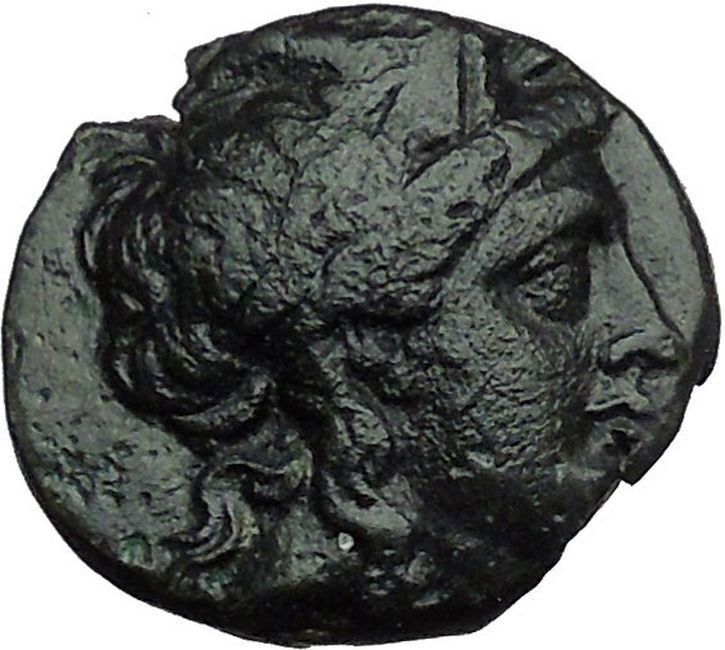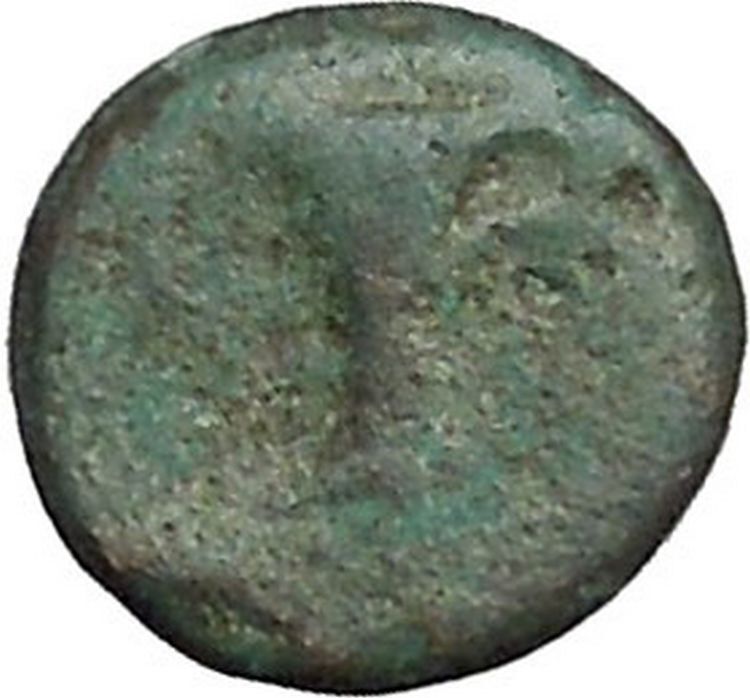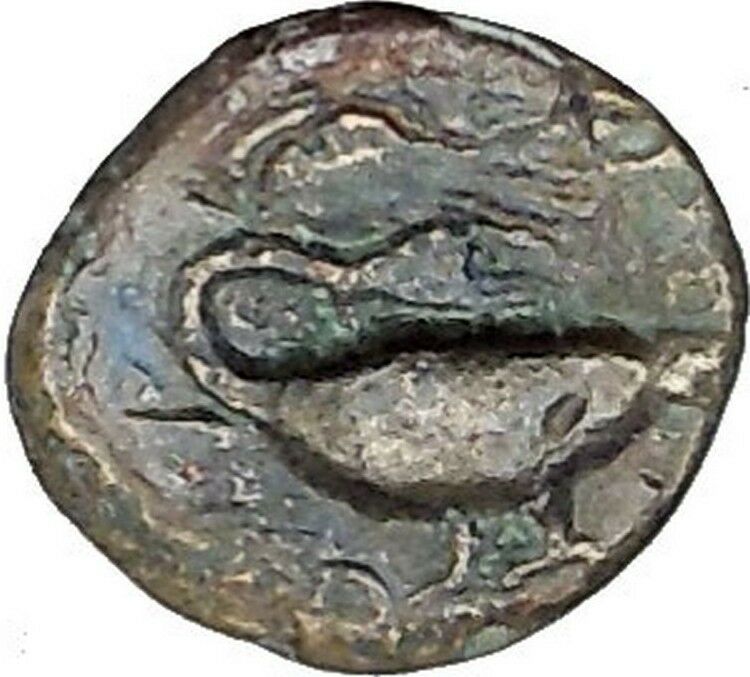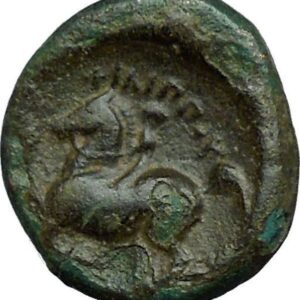|
Kingdom of Cappadocia
Ariarathes IX, Eusebes Philopator – King: 101-87 B.C.
Silver Drachm 17mm (3.71 grams) Struck 98/97 B.C.
Reference: Sear 7298
Certification: NGC Ancients XF 4285239-014
His diademed head right with slightly older portrait with features resembling his father VI the Great of Pontus.
Athena standing left, holding Nike (whom stands right with wreath), spear and shield; ΒΑΣΙΛΕΩΣ / APIAPAΘOV on left and right; in exergue, EYΣEBOYΣ / Δ ( = regnal year 4 = 98/97 B.C. ).
Son of Mithradates VI of Pontus, the was only eight years of age when his father placed him on the Cappadocian throne. His elevation was opposed both by the Cappadocians themselves and by the Romans, who eventually succeeded in having him deposed in 89 B.C. Two years later he died in Thessaly during the First Mithradatic War.
You are bidding on the exact item pictured, provided with a Certificate of Authenticity and Lifetime Guarantee of Authenticity.
Ariarathes IX Eusebes Philopator (Ancient Greek: Ἀριαράθης Εὐσεβής Φιλοπάτωρ, Ariaráthēs Eusebḗs Philopátōr; reigned ca. 101-89 BC or 96 BC-95 BC), was made king of Cappadocia by his father King Mithridates VI of Pontus after the assassination of Ariarathes VII of Cappadocia. Since he was only eight years old, he was put under the regency of the Cappadocian Gordius. He was early overthrown by a rebellion by the Cappadocian nobility who replaced him with Ariarathes VIII of Cappadocia, whom Mithridates promptly expelled, restoring Ariarathes IX. In 95 BC the Roman Senate ordered to depose him and, after a short period of direct Pontic rule, a brief restoration of Ariarathes VIII and an attempt of instauration of a Republic, put in his place a man chosen by the Cappadocians, who rejected the idea of a Republic: the choice fell on Ariobarzanes I Philoromaios, who was expelled by Mithridates’s ally Tigranes the Great, bringing to the brief restoration of Ariarathes IX, who was deposed once again by the Romans in 89 BC. Two years later, in 87 BC, Ariarathes IX died fighting for his father in Thessaly.

Mithridates VI or Mithradates VI (Greek: Μιθραδάτης), from Old Persian Mithradatha, “gift of Mithra”; 134-63 BC, also known as Mithradates the Great (Megas) and Eupator Dionysius, was king of Pontus and Armenia Minor in northern Anatolia (now Turkey) from about 120-63 BC. Mithridates is remembered as one of the Roman Republic’s most formidable and successful enemies, who engaged three of the prominent generals from the late Roman Republic in the Mithridatic Wars: Lucius Cornelius Sulla, Lucullus and Pompey. He was also the greatest ruler of the Kingdom of Pontus.
The Kingdom of Cappadocia was a Hellenistic-era kingdom centered in the historical region of Cappadocia in Asia Minor (present-day Turkey). It developed from the former Achaemenid satrapy of Cappadocia, and it was founded by its last satrap, Ariarathes (later Ariarathes I). Throughout its history, it was ruled by three families in succession; the House of Ariarathes (331-96 BC), the House of Ariobarzanes (96 BC-36 BC), and lastly that of Archelaus (38 BC-17 AD)[contradictory]. In 17 AD, following the death of Archelaus, during the reign of Roman emperor Tiberius (14-37), the kingdom was incorporated as a Roman province.
Origins and history
Ariarathes I had been satrap of Cappadocia for 19 years and a loyal supporter of the Achaemenid kings. By blood, he was related to the ruling Achaemenid house (“Cyrus and Darius’ Seven”) as well as other satraps. When Alexander of Macedon invaded the area as part of his conquest, he appointed two temporary governors. Following Alexander’s death, Ariarathes I managed to assume power in Cappadocia, and become the first king of the newly established Kingdom of Cappadocia. Ariarathes’s line would provide the first ten kings of the kingdom. After a period of Seleucid overlordship, the Cappadocian Kingdom gained its independence during the reign of Ariarathes III (c. 255-220). The Ariarathid dynasty was abolished by the early course of the 1st century BC by the ruler of the Kingdom of Pontus, the infamous Mithridates VI (Eupator), this in an attempt to fully subdue the Cappadocian Kingdom. However, in “conflict” with the interests of the Roman Republic, the latter supported the Cappadocians to choose a new king; this came to be another Iranian nobleman, namely, Ariobarzanes I. Following the civil war in Rome, the latter would now interfere more directly in Cappadocian affairs; in 36 BC, Marcus Antonius appointed Archelaus, a local noble, to the Cappadocian throne. When, at an old age, Tiberius summoned him to Rome, he died there of natural causes; Cappadocia was subsequently incorporated as a fully functioning Roman province. Due to the kingdom’s perilous location amongst powerful neighbors, the kings were often involved in beneficial marriage alliances, such as with the Mithridatic dynasty as well as the Seleucid dynasty.
Religion
Following the Macedonian conquests, the Persian colonists in Cappadocia as well as elsewhere were cut off from their co-religionists in Iran proper. Strabo, who observed them in the Cappadocian Kingdom in the first century B.C., records (XV.3.15) that these “fire kindlers” possessed many “holy places of the Persian Gods”, as well as fire temples. The kingdom’s domains possessed numerous sanctuaries and temples of various Iranian gods and deities, as well as Iranized deities. On their significant importance, numerous sanctuaries and deities of this category were noted by Strabo. Some of these are Anahita at Castabala, the magus Sagarios at Ariaramneia, and Ahura Mazda at Arebsum. In enclosures, known as Pyraitheia, there was worship in the name of the Zoroastrian religion. Regarding these Pyraitheia, he furthermore relates that “. . . in their midst there is an altar, on which there is a large quantity of ashes and where the magi keep the fire ever burning.”
Administration
Initially, the kingdom was organized in ten satrapies. Later, this became eleven. The satrapies were called by the Greek term strategiai, and each of them were headed by the strategos, basically an important noble. The eleven satrapies were; Melitene, Cataonia, Cilicia, Tyanitis, Garsauritis, Laouiansene, Sargarausene, Saraouene, Chamanene, Morimene, and Cilicia Tracheia. Cilicia Tracheia, the eleventh and last satrapy, was added later to the kingdom.
Control over the lands of the kingdom was maintained through royal estates and fortifications protected and maintained by nobility. There were two types of estates: those located and centered on the residence of the noble in question (whose power, as the Encyclopedia Iranica adds, “was foremost temporal”) and the so-called temple estates. Within these so-called temple estates, the priests had both temporal power as well as a religious function. As a result of the double role the clergy played, they were the highest in power after the king himself.
Hellenization
In imitation of their larger, western neighbors, the Seleucids and Attalids, the Cappadocian kings Hellenized various aspects of the kingdom on purpose. Both the members of the Ariarathid as well as that of the Ariobarzanid houses would receive a Greek education, and adopted Hellenic titles, such as basileus, instead of the native shah. Although the first few Cappadocian kings, that is, of the Ariarathid family, minted Iranian-style coins with Aramaic descriptions, from king Ariarathes III and on, they shifted to using Greek-style coins and inscriptions. During the reign of Ariamnes, the first coins appeared with Greek inscriptions, with the monarch depicted on it in Persian dress. Like the Seleucids, the Cappadocian kings named newly founded cities after themselves (e.g., Ariaramneia, Ariarathei, Archelais). Furthermore, all three royal houses were “honored” by the Greek poleis. Roughly speaking, Hellenization in the kingdom started slowly from the course of the 3rd century BC, and quickened in the 2nd. Nevertheless, until the end of the kingdom, all its rulers bore Iranian names.
Architecture
According to Strabo, the capital Mazaca was well-developed and had a large population. It was surrounded by numerous villages and plantations, all of these well protected in turn by fortifications controlled by members of the royal family and the nobility.
Kings of Cappadocia
See also: List of kings of Cappadocia
- Ariarathes I 331 – 322 BC
- Ariarathes II 301 – 280 BC
- Arianes 280 – 230 BC
- Ariarathes III 255 – 220 BC
- Ariarathes IV 220 – 163 BC
- Ariarathes V 163 – 130 BC
- Ariarathes VI 130 – 116 BC
- Ariarathes VII 116 – 101 BC
- Ariarathes VIII 101 – 96 BC
- Ariarathes IX 101 – 96 BC
- Ariobarzanes I 96 – ca. 63 BC
- Ariobarzanes II c.63 – 51 BC
- Ariobarzanes III 51 – 42 BC
- Ariarathes X 42 – 36 BC
- Archelaus 38 – 17
|















